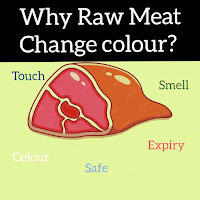For most of us Chefs the raw meat turning brown is a big concern and today we will know, If this meat is really safe to eat or not..
Colour change is just one sign that meat may not just be fresh but safe for consumption, change in appearance does not always indicate spoilage. When it comes to the safety of raw meat, there’s more to know than just appearance.
All chefs should be conscious of what to look for and how to identify meat that safe to eat while purchasing, receiving or storing raw meats.Food Handlers must never guess whether meat is safe to cook and serve to customers and should always follow the “if in doubt, throw it out” principle if unsure of the meat’s freshness.
but, do you know why raw meat changes colour?
We’ll use the example of raw minced beef. If it begins to brown, the simple reason is that it has been exposed to oxygen. There are other reasons why raw meat may turn brown, such as its temperature, any exposure to light and microbial growth. Sometimes the meat may be greyish-brown inside, but not due to spoilage. That colour actually indicates a lack of exposure to oxygen, which is normal.
You must have noticed that most supermarkets have discount on meats, such as minced beef, that has turned brown, not expired the shelve life. If the meat turns brown or grey on the outside, though, it’s likely not yet unsafe, but it is beginning to rot.
Most important is food handlers should not accept any foods that may be close to expiring, as chances are, by the time it reaches the end consumer, it will have gone bad
The Signs of spoiled Meat, Seafood or Chicken:
A bad smell, a slimy or sticky texture as well as discolouration.
Look at, Touch and Smell the meat for important clues about its freshness.
Look: Red meat should be bright red — that’s when it’s at its freshest. If it turns purple or brown-ish, it is probably still safe to eat, but it has been exposed to some oxygen. As raw chicken spoils, it turns from pink to a greyish colour. It’s best not to serve it to customers.
Touch: Press the meat firmly with your finger. If it’s fresh, it will spring back. If it’s older, it may have lost some of that firmness. It should never feel slimy or sticky.
Smell: Smell the meat to make sure it doesn’t have a strong odour. Most fresh meat will have almost no smell. Lamb may have a slightly gamey scent, but if there is a foul odour, it has almost certainly gone bad.
Food Handlers must never cook and serve meat if they are unsure of its freshness. Know how to check meat for spoilage when purchasing meat or receiving a delivery, as well as proper storage practices. Always throw out meat if you are unsure if it has gone bad.
When checking deliveries, always:
Check that meat is delivered at 5°C or below.
Ensure frozen meat products are frozen solid and don’t show signs of thawing.
Make sure meat is tightly wrapped and there are no tears or holes in the packaging.
Be wary if there is excessive liquid in packaging, which can be an indication that temperature rules are not adhered to. Use a clean, calibrated thermometer to check.
Check packaging dates and best before dates.
Smell the meat — spoiled red meat will have a strong, distinct odour.
Make sure the meat is not slimy or sticky — this is a common sign of bacterial growth.
If the above requirements are not met, staff should reject the delivery.
Storing meat safely
Store meat in the refrigerator at 5°C or below or in the freezer at -15°C or below.
Store meat products before less hazardous foods, as meat can only be kept at room temperature for two hours before it must be discarded.
Keep raw meat away from cooked food in the refrigerator and store it on the bottom shelf, below cooked foods or fresh produce.
Make sure coolers are equipped with thermometers and food handlers are checking the temperatures regularly.
If you grind your own meat in-house, refrigerate and use it within 24 hours, or freeze it.
Follow the “First In, First Out” (FIFO) method: This means that food purchased first should be used first.
Extra caution is needed for potentially hazardous foods
Meat is a high-risk, or potentially hazardous, food. High-risk foods are those that have ideal conditions for bacterial growth, therefore are more likely to harbour dangerous bacteria and pathogens like viruses or parasites. High-risk foods are neutral in acidity, high in starch or protein, and are moist.
Food Handlers must closely follow proper time and temperature controls when handling high-risk foods such as meat, poultry, seafood, eggs and dairy. These practices will help keep bacteria from growing and minimise the risks of food-borne illness outbreaks. Learn more about the Food Safety.
Next :
at what temperature should raw meat be stored
how to defrost raw meat quickly
on what level of the fridge should raw meat be stored
parasites in raw meat
raw meat cross contamination
raw meat danger zone
what must be included on the packaging label for raw meat
where should raw meat be stored in a refrigerator












0 comments:
Post a Comment